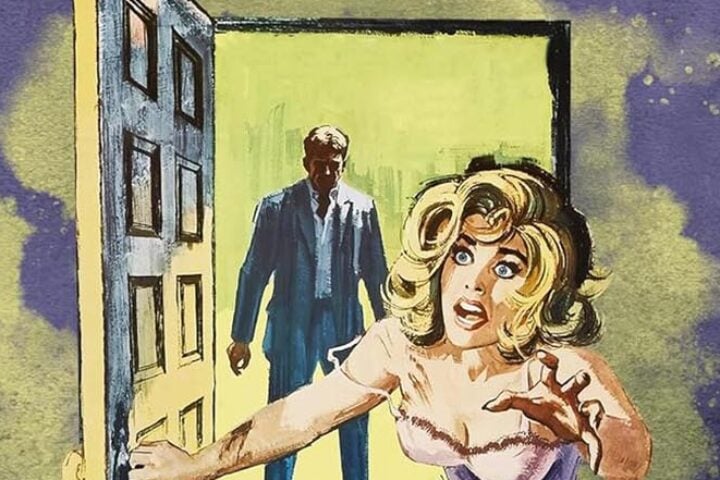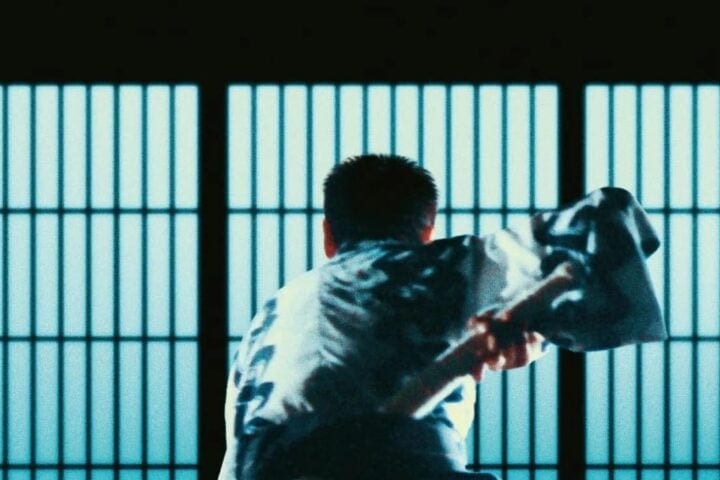Fernando Arrabal’s Viva la Muerte is a mostly autobiographical account of the filmmaker’s youth during the Spanish Civil War that intermingles with disturbingly surreal dreams and fantasies. This alienation effect is rendered all the more unsettling since Arrabal opts to shoot the imaginal sequences on heavily color-filtered video, aligning them with Nam June Paik’s avant-garde video art. Another sort of alienation may stem from some unsimulated violence against animals, in particular a jaw-dropping scene in a slaughterhouse that combines the in-your-face verité of Georges Franju’s Blood of the Beasts with the dynamic writhing of Isadora Duncan.
Viva la Muerte opens at the end of the war, with a jeep full of fascist soldiers declaring the titular phrase and vowing to kill half of Spain’s population if that’s what it takes to cleanse the nation from the pernicious influence of atheism and communism. Young Fando (Mahdi Chaouch) looks on, but he’s mostly concerned with the fate of his father (Ivan Henriques), who was denounced at the start of the war as an revolutionary by Fando’s right-wing mother (Núria Espert). Over the course of the film, Fando learns tatters of information about his father’s fate, an effective compression of events that took up much more of Arrabal’s own life.
Viva la Muerte hauntingly illustrates the authoritarianism and repression exerted on the Spanish people through the Catholic church, General Franco’s nationalist regime, and what Friedrich Engels called “the holy family.” The film shows the complicity of the first two in a fantasy sequence where the local priests blesses a queue of soldiers and passes each one a sanctified rifle. The intolerance of the Franco regime is depicted in a grim scene in which a firing squad executes a row of partisans, one of whom survives, only to be finished off by a gunshot up his ass. The voiceover refers to the death of venerated poet Federico Garcia Lorca, targeted by Franco’s nationalists not only for his politics but also for his homosexuality.
But it’s Fando’s family that comes in for the brunt of Arrabal’s ire. His disapproving grandmother (Suzanne Comte) seems obsessed over which side he dresses his package on, yet holds his finger to the fire for a minor misdeed. The father, of course, is absent. His mother is a figure of deep ambivalence. At one point, Fando visualizes her as a resplendent Madonna, then imagines her eyeing him with a knife clutched between her teeth.
Arrabal chooses to split the mother figure symbolically in two: between the unsullied purity of his real mother and the sadomasochistic inclinations of Aunt Clara (Anouk Ferjac), who brings out conflicted sexual notions in Fando. Fando’s fantasies invariably involve viscous fluids of questionable provenance and damage done to round objects (eggs, eyes, and so on) that speaks to a serious case of castration anxiety. These abject imaginings recall the writings of Georges Bataille, especially his scandalously pornographic novella Story of the Eye.
Arrabal was one of the founders of the Panic Movement alongside Chilean-born polymath Alejandro Jodorowsky and French artist and writer Roland Topor. They wanted to supplant the boundaries of contemporary surrealism, which they considered cliquish and staid. In the era of the happening and the growing counterculture, they sought confusion, chance events, and an aesthetic that was founded on what Topor referred to as “blood, shit, and sex,” and direct connections between the three artists are evident throughout Viva la Muerte.
Topor’s distinctively crosshatched and decidedly Boschian ink drawings illustrate the closing credits (there are no opening credits). And the film’s final scene shows a debilitated Fando being carted off into the blue empyrean by his friend Thérèse (Jazia Klibi), a denouement that plays as a sort of inverse of Fando y Lis, a 1968 Jodorowsky film inspired by an Arrabal play. Viva la Muerte combines and transcends these influences to emerge as the work of a distinctively idiosyncratic sensibility that turns a pitiless but not humorless eye on the forces of misrule, intolerance, and repression that occur not only within a historical horizon but that, owing to the lamentable foibles of human nature, remain with us today.
Image/Sound
Radiance offers Viva la Muerte in a sparkling new 4K restoration, sourced from both the original 35mm camera negative and a 35mm interpositive, that’s a definite upgrade from Cult Epics’s earlier DVD release in terms of vibrancy of color and clarity of detail, especially in scenes shot using heavily color-filtered videotape. Audio comes in a French LPCM mono mix that’s a sturdy workhorse when it comes to conveying the dialogue and the jaunty children’s song “Ekkoleg” by Danish composer Grethe Agatz that recurs throughout the film.
Extras
A 66-minute episode of The Projection Booth podcast from 2020 with host Mike White moderating critics Heather Drain and Jess Byard is so thorough as to effectively serve as a commentary track for Viva la Muerte. The trio discuss their initial exposure to the film, its themes and symbolism, connections with other films and filmmakers, and their appreciation of boundary-pushing cinema. A short making-of documentary by Abdellatif Ben Ammar shows Fernando Arrabal at work on the film, including footage of the fantasy sequences without the heavily colored filters, while the soundtrack features Arrabal musing about the film medium and actor Mahdi Chaouch reading extracts from the source material.
In a new interview recorded for this release, scholar and Spanish cinema expert David Archibald discusses the surrealist influence on Viva la Muerte, particularly how it embodied the surrealist desire to weld reality and dream. Archibald also provides some historical context about the Spanish Civil War. Elsewhere, the feature-length documentary Vidarrabal is an engaging overview of the filmmaker’s life and career, with plenty of emphasis on the Panic Movement era. Finally, the enclosed booklet features a 1976 interview with Arrabal and an essay from critic Sabina Stent about the intersection of the surreal and the violent in Arrabal’s cinema.
Overall
Fernando Arrabal’s Viva la Muerte embodies the surrealist desire to meld the real and the dreamlike in the filmmaker’s recollections of his youth during the Spanish Civil War.
Since 2001, we've brought you uncompromising, candid takes on the world of film, music, television, video games, theater, and more. Independently owned and operated publications like Slant have been hit hard in recent years, but we’re committed to keeping our content free and accessible—meaning no paywalls or fees.
If you like what we do, please consider subscribing to our Patreon or making a donation.



